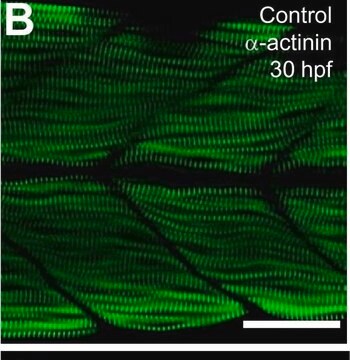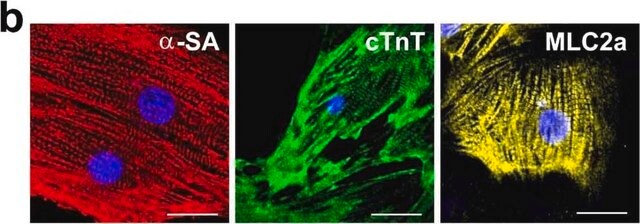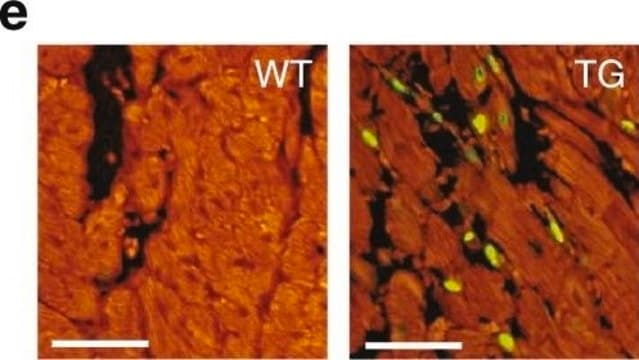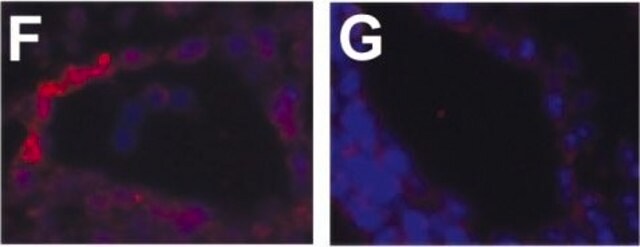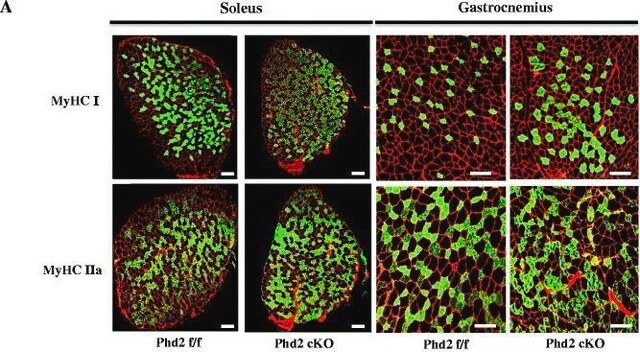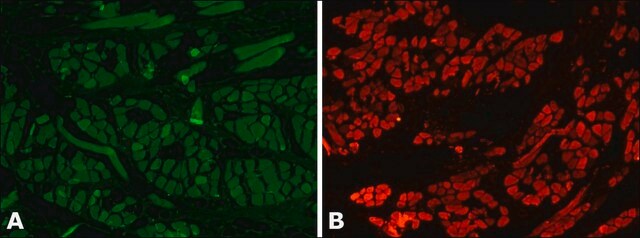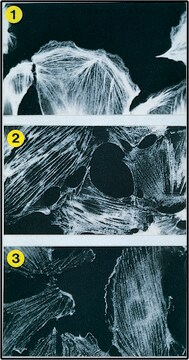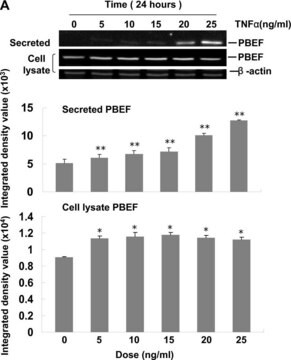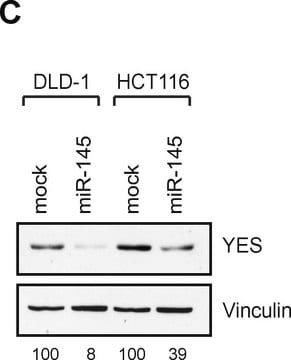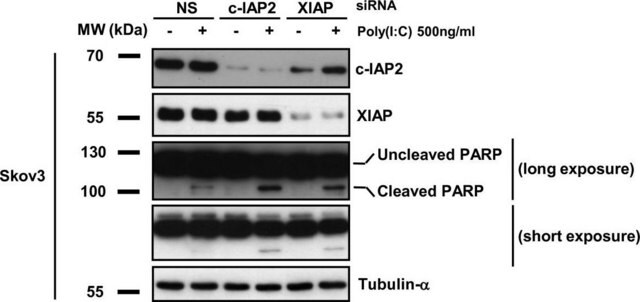추천 제품
생물학적 소스
mouse
Quality Level
결합
unconjugated
항체 형태
ascites fluid
항체 생산 유형
primary antibodies
클론
BM-75.2, monoclonal
분자량
antigen 100 kDa
포함
15 mM sodium azide
종 반응성
mouse, bovine, human, chicken
기술
indirect immunofluorescence: 1:200 using cultured chicken fibroblasts
microarray: suitable
western blot: suitable
동형
IgM
UniProt 수납 번호
배송 상태
dry ice
저장 온도
−20°C
타겟 번역 후 변형
unmodified
유전자 정보
human ... ACTN1(87)
mouse ... Actn1(109711)
관련 카테고리
일반 설명
α-actinin is a 100kD actin binding protein found in muscle as well as non-muscle cells. In smooth muscle, α-actinin is identified in dense bodies and plaques characteristic of tissues whereas it is associated with z-discs that define muscle sarcomas in normal skeletal muscle. Monoclonal anti-α-actinin antibody can be used in immunoblotting to study the membrane anchorage sites and immunochemical identification of α-actinin. It can also be used in immunofluorescence to study the localization of α-actinin in cultured cells and tissues. Mouse anti-α-actinin antibody reacts specifically with chicken fibroblasts. The product has also shown reactivity for mouse and human cells.
The gene encoding α-actinin is mapped to the human chromosome 11q13.2. α-actinin belongs to the spectrin protein superfamily.
면역원
cytoskeletal fraction of bovine mammary gland epithelial (BMGE) cells.
애플리케이션
Immunofluorescence of cardiomyocytes from neonatal and adult mouse hearts was performed using monoclonal mouse anti-α actinin (clone EA-53) at 1:1000.
May be used in the study of skeletal muscle organization and in studies of the membrane anchorage sites of actin.
Monoclonal anti-α-actinin antibody (diluted 1: 500) can be used in native protein binding assays. It can also be used in western blot, microarray, immunohistochemistry and in Immunofluorescence microscopy.
생화학적/생리학적 작용
α−actinin regulates muscle contraction and cytoskeletal organization. It promotes cell migration and acts as an actin crosslinker. Mutations in the α-actinin gene is observed in heterogeneous hypertrophic cardiomyopathy and in juvenile onset atrial fibrillation.
면책조항
Unless otherwise stated in our catalog or other company documentation accompanying the product(s), our products are intended for research use only and are not to be used for any other purpose, which includes but is not limited to, unauthorized commercial uses, in vitro diagnostic uses, ex vivo or in vivo therapeutic uses or any type of consumption or application to humans or animals.
적합한 제품을 찾을 수 없으신가요?
당사의 제품 선택기 도구.을(를) 시도해 보세요.
Storage Class Code
10 - Combustible liquids
WGK
nwg
Flash Point (°F)
Not applicable
Flash Point (°C)
Not applicable
이미 열람한 고객
Protein Interactions with the Glucose Transporter Binding Protein GLUT1CBP That Provide a Link between GLUT1 and the Cytoskeleton.
Robert C. Bunn, Mari Anne Jensen
Molecular and Cellular Biology, 10(4), 819-832 (1999)
Thomas A Hawkins et al.
Development (Cambridge, England), 135(6), 1147-1156 (2008-02-08)
The mechanisms that regulate sarcomere assembly during myofibril formation are poorly understood. In this study, we characterise the zebrafish sloth(u45) mutant, in which the initial steps in sarcomere assembly take place, but thick filaments are absent and filamentous I-Z-I brushes
C A Conley
American journal of physiology. Cell physiology, 280(6), C1645-C1656 (2001-05-15)
Evidence is accumulating to suggest that actin filament remodeling is critical for smooth muscle contraction, which implicates actin filament ends as important sites for regulation of contraction. Tropomodulin (Tmod) and smooth muscle leiomodin (SM-Lmod) have been found in many tissues
Kate G R Quinlan et al.
Human molecular genetics, 19(7), 1335-1346 (2010-01-22)
Approximately one billion people worldwide are homozygous for a stop codon polymorphism in the ACTN3 gene (R577X) which results in complete deficiency of the fast fibre muscle protein alpha-actinin-3. ACTN3 genotype is associated with human athletic performance and alpha-actinin-3 deficient
Gabriele Giacomo Schiattarella et al.
PloS one, 10(7), e0131662-e0131662 (2015-07-07)
Mucopolysaccharidosis (MPS) IIIB is a lysosomal disease due to the deficiency of the enzyme α-N-acetylglucosaminidase (NAGLU) required for heparan sulfate (HS) degradation. The disease is characterized by mild somatic features and severe neurological disorders. Very little is known on the
자사의 과학자팀은 생명 과학, 재료 과학, 화학 합성, 크로마토그래피, 분석 및 기타 많은 영역을 포함한 모든 과학 분야에 경험이 있습니다..
고객지원팀으로 연락바랍니다.